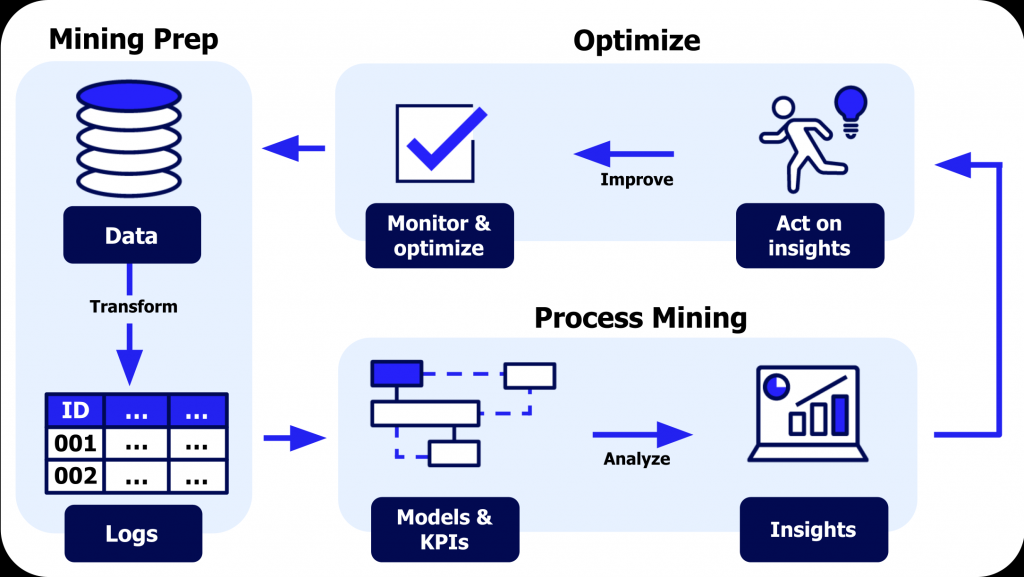Process Mining
 Process Mining is a new approach which can help to organization to identify, improve and track their processes. In these days, it is not good idea to identify processes via meeting, interview and simply observing. I is best to rely on data rather than the words. On the other hand, six sigma is one of the most pivotal approaches for process improvement via variation reduction. However, from a data science point of view, traditional Six Sigma techniques cannot easily respond process complexity and large amounts of data. Process mining not only improves Six Sigma methodology, but also eliminates non-value-added activities such as over-processing waste and waiting time via process discovery algorithms. Recently, organizations face new challenges including complex processes and large amounts of data. Traditional Six Sigma techniques usually rely on only statistical approaches to reduce variation in business processes. The data collection system is preformed manually and it can take considerable time and cost. Six Sigma projects benefit from the DMAIC approach including Define, Measure, analyze, Improve and Control. In the define phase, we need to define the problems and set targets, measure key performance indicator and gather data, analyze the data to find cause and effect relationship, improve the current process and control and sustain process deviation from the target.
Process Mining is a new approach which can help to organization to identify, improve and track their processes. In these days, it is not good idea to identify processes via meeting, interview and simply observing. I is best to rely on data rather than the words. On the other hand, six sigma is one of the most pivotal approaches for process improvement via variation reduction. However, from a data science point of view, traditional Six Sigma techniques cannot easily respond process complexity and large amounts of data. Process mining not only improves Six Sigma methodology, but also eliminates non-value-added activities such as over-processing waste and waiting time via process discovery algorithms. Recently, organizations face new challenges including complex processes and large amounts of data. Traditional Six Sigma techniques usually rely on only statistical approaches to reduce variation in business processes. The data collection system is preformed manually and it can take considerable time and cost. Six Sigma projects benefit from the DMAIC approach including Define, Measure, analyze, Improve and Control. In the define phase, we need to define the problems and set targets, measure key performance indicator and gather data, analyze the data to find cause and effect relationship, improve the current process and control and sustain process deviation from the target.
Process Mining can improve the Six Sigma capabilities and cover the gap between data science and statistical attitudes. For instance, some of the process mining algorithms are time-based, and they can represent service time, waiting time, sojourn time, remaining time and elapsed time for every activity of the process. Process Mining uses timestamp to visualize bottlenecks, waiting time and the other mentioned time-based indicators. The key point is that a preexistent model is not required, and process is discovered by the process mining tools such as ProM. If you would like to discover a model from an event log, you need to extract a table with case id, event id, start time, end time, activity, resource and etc. We make the event data via SQL queries or web services. Then you can benefit from the good algorithms such as inductive miner to create your model. Inductive miner not only can cope with infrequent behavior, but can also convert model to other notations like BPMN and Petri nets. With the help of inductive miner, you can also have the time-based indicators for each activity. For analyzing we can use the Root Cause Analysis like Pareto, Regression and hypothesis testing. However sometimes the problems are related to the redundant activities and incorrect sequences. Moreover, you can understand which activities and paths are bottleneck. For improvement you can remodel your process and use SLA for your employees to manage your time management. Overall, you can create the process model by event logs and event data. After that, you can do conformance checking for your process model. Also, with the help of process mining you can use operational support algorithms, but what does it mean? some of the process mining algorithms can learn the past and predict the future and also suggest good possible solutions to achieve more valuable goals to improve your productivity. As a result, the process mining is excellent for both complete and incomplete cases.
